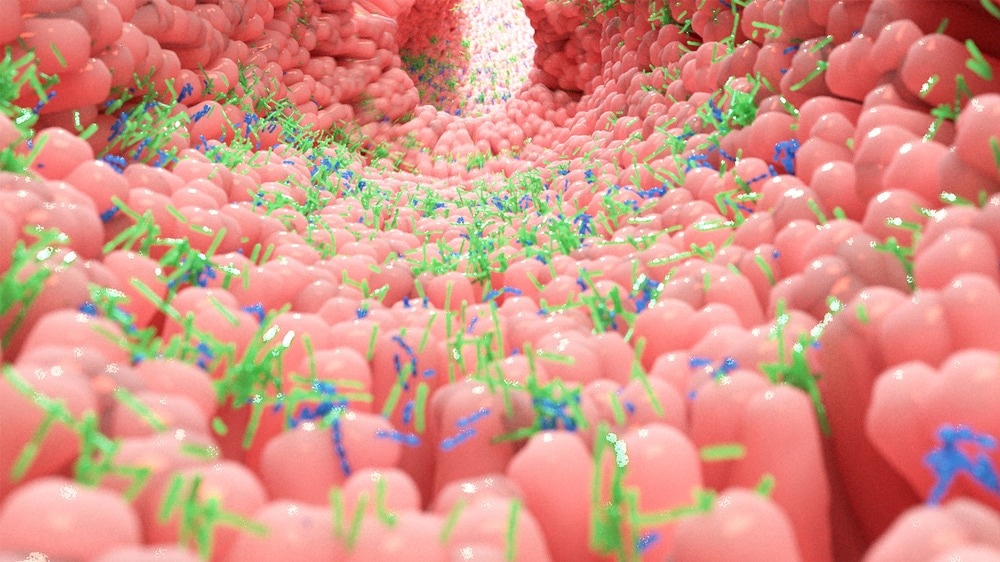Reviewed by Danielle Ellis, B.Sc.Dec 15 2023
The gut microbiome, comprising numerous bacterial species, serves as a residence for various bacteria within the human digestive system.

Image Credit: Alpha Tauri 3D Graphics/Shutterstock.com
Among its significant health benefits is the safeguarding of the gut against potential threats from invading pathogens, which are microorganisms capable of causing diseases. However, the mechanism behind this protective effect has remained unclear, raising questions about the specific roles of different bacterial species in this process.
To address this uncertainty, scientists from the University of Oxford conducted experiments on 100 distinct strains of gut bacteria, both individually and in combinations. The objective was to assess their effectiveness in impeding the growth of two harmful bacterial pathogens, namely Klebsiella pneumoniae and Salmonella enterica. The results revealed that individual gut bacteria exhibited limited capacity to restrain the proliferation of either pathogen.
However, when communities consisting of up to 50 different species were cultivated together, the pathogens demonstrated up to 1000 times less efficiency in growth compared to when cultivated with any single species.
This phenomenon, termed the “community protection effect,” was observed consistently, whether the bacteria were cultured together in vials or in germ-free mice, which initially lacked resident gut bacteria at the onset of the experiments.
These results clearly demonstrate that colonization resistance is a collective property of microbiome communities; in other words, a single strain is protective only when in combination with others.”
Kevin Foster, Professor, Departments of Biology and Biochemistry, University of Oxford
However, the investigators discovered that the efficacy of protection was not solely influenced by the overall diversity of bacterial communities. Rather, specific members within these communities played a crucial role in determining the level of protection. Surprisingly, certain species, although individually offering minimal protection, proved indispensable for the collective defense provided by the community.
The researchers illustrated that protective bacterial communities hindered pathogen growth by depleting the essential nutrients required by the pathogens. Through an examination of the genomes of various bacterial species, they identified that the most effective protective communities comprised species with protein compositions strikingly similar to those of the pathogenic species.
Additionally, the researchers employed metabolic profiling to showcase that the protective species exhibited analogous requirements for carbon sources as pathogens.
Crucially, although increased microbiome diversity increases the probability of protection against these pathogens, the overlap in nutrient utilization profiles between the community and the pathogen is key. Certain species that have a crucial role in community protection show a high degree of metabolic overlap with the pathogen, and therefore similar nutrient demands.”
Frances Spragge, Departments of Biology and Biochemistry, University of Oxford
Applying the nutrient blocking principle, the researchers employed it to anticipate bacterial communities varying in their ability to provide protection against a distinct pathogen: an antimicrobial-resistant E. coli strain.
In experimental trials, the communities with the highest nutrient overlap with the E. coli strain demonstrated up to a 100-fold increase in effectiveness in reducing the pathogen's abundance compared to communities predicted to offer weaker protection.
The researchers suggest that these newfound insights could be harnessed to develop innovative strategies for combating harmful gut pathogens by optimizing the composition of gut microbiome communities.
Furthermore, these findings may shed light on why individuals can become more vulnerable to species such as K. pneumoniae following antibiotic treatments that reduce the diversity of gut microbiome species.
Our work supports the general hypothesis that a more diverse microbiome can carry health benefits. This gives promise to the goal of optimizing the composition of microbiomes to protect against bacterial species that are harmful to health.”
Dr Erik Bakkeren, Departments of Biology and Biochemistry, University of Oxford
Source:
Journal reference:
Spragge, F., et al. (2023) Microbiome diversity protects against pathogens by nutrient blocking. Science. doi.org/10.1126/science.adj3502.